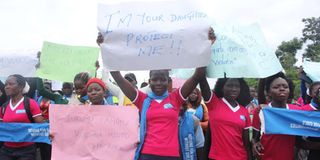The downside of social norms that entrench GBV

Young women protest against the rise in sexual and gender-based violence. Many people think that GBV refers only to physical battery, with verbal forms being treated as harmless.
What you need to know:
- A workshop for community human rights defenders reiterated that socio-culture normalises GBV and leads to high levels of toleration.
- Many people think that GBV refers only to physical battery, with verbal forms being treated as harmless.
Various studies have established that male intimate partners are the main perpetrators of gender-based violence (GBV). In a 2021/22 study covering Nairobi, Makueni and Nakuru counties, researchers from Kenyatta University’s Women’s Empowerment Hub identified husbands as the principal perpetrators of the vice.
A 2020 study by Performance Monitoring and Action (PMA), a partnership of the International Centre for Reproductive Health-Kenya, Kenyatta University and Johns Hopkins University focusing on female youth aged 16–24 in informal settlements in Nairobi, noted that during the Covid-19 lockdowns, 17 per cent of the young women experienced intimate partner violence (IPV).
More than half relied on the mass media to receive information from the government and nongovernmental organisations (NGOs) about services for GBV survivors. Interestingly, parents, teachers and religious institutions did not feature among sources of information.
The study also noted that a number of GBV issues are not captured in available literature. For instance, the Kenya Demographic and Health Survey report of 2022 does not cover sexual harassment, help-seeking norms, stigma, access to justice for survivors and menstrual hygiene.
It has limited data on women’s empowerment, reproductive coercion and men’s voices. The 2020 PMA study itself did not include stigma, response by the judicial system and barriers to justice.
A recent workshop for community human rights defenders aligned to the Wangu Kanja Foundation reiterated that socio-culture normalises GBV and leads to high levels of toleration. For instance, the norm that coitus is integral to marriage renders women captive to coercive and non-consensual intercourse. Religious indoctrination that marriage is permanent conditions women to stay in abusive relationships.
And women in public spaces receive endless sexually suggestive comments with perpetrators assuming that these remarks are complimentary.
Several other concerns were highlighted. Many people think that GBV refers only to physical battery, with verbal forms being treated as harmless. Few people are aware of technology-assisted GBV and laws against them. Fear of stigma and hostile treatment by health service providers deter reporting.
Older persons protect perpetrators by resorting to traditional dispute resolution mechanisms even in criminal cases. NGOs addressing GBV are accused of misandry. Release of perpetrators on police bond emboldens and gives them an opportunity to intimidate their accusers.
Discussions revealed a discordance between official policy and implementation with regard to the P3 form that is mandatory for reporting violence.
Although this form is officially free, workshop participants regretted that it is, in reality, sold for as much as Sh1,000, making it a barrier to, rather than facilitator of, justice. Why this continues without any action from the government remains baffling.
Survivor needs
A key concern was that policies and programmes about GBV are routinely formulated without the inputs of survivors. To what extent then are they responsive to the needs of survivors? Related was the citizen-friendliness of existing laws on GBV. Which of them are available in local languages? To what extent are they simplified for consumption by ordinary citizens? Are citizens ever involved in formulating the implementation regulations on them?
Concerns about policing revolved around the staffing and efficacy of gender desks in police stations, lumping of gender issues under community policing and doubts about whether the newly established special GBV courts will make any difference if not streamlined from lower down in terms of reporting and investigation.
Preliminary findings of a follow-up PMA research conducted from June to August 2023 show that 28.1 per cent of the young women experienced IPV in the past year with 23.6 per cent and 17.8 per cent going through physical and sexual forms respectively, and 13 per cent being exposed to both.
This constitutes a rise of 11.1 per cent from 2020. Sexual harassment affected one third of the women and was mostly manifested in ogling and unwanted sexual comments and gestures. More than 70 per cent of the women felt unsafe in public spaces.
Approximately half discussed their experiences, mostly with friends (71.7 per cent) and relatives (31.2 per cent). About one third of survivors sought help, and mostly received counselling services. The main barriers to seeking help were embarrassment, fear and a mindset that the violence was really not a problem.
This study confirmed that social norms entrench GBV. For example, a respondent cited pressure not to report the abusive partner, the warning being that this would wreck the marriage. Another indicated that people who intervened to help battered women were demonised as intruders in private family affairs.
These findings and reflections from the workshop point to the need to broaden inclusion of stakeholders in policymaking and use of evidence in establishing preventive and responsive measures, including strengthening access to justice for survivors.
They also call for greater focus on the domestic sphere in combating the vice. The workshop recommended that academics should co-create research questions with communities to enhance resonance with practical needs.
The writer is an international gender and development consultant and scholar ([email protected]).





